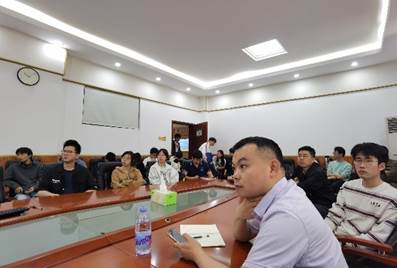中南大学名师名家论坛——伍伦贡大学李会军教授在轻合金研究院作报告
发布时间:2025-04-14 作者: 来源: 浏览次数:
应中南大学轻合金研究院喻海良教授诚挚邀请,伍伦贡大学李会军教授于 2025 年 4 月 10 日至 14 日期间到访中南大学,开展了一系列深入且富有成效的学术交流活动。
4 月 14 日,李会军教授在中南大学潇湘校区中铝科技大楼 C204 会议室,带来了一场主题为《电弧增材制造中数字李生技术的研发》的精彩学术报告。此次报告由中南大学轻合金研究院喻海良教授主持,中南大学轻合金研究院崔晓辉研究员等众多师生齐聚一堂,共同参与了这场学术盛宴。

李会军教授进行学术报告


与会师生聆听学术报告
在报告中,李会军教授凭借深厚的学术造诣和丰富的研究经验,极为详细地阐述了金属电弧增材制造中数字李生技术的研发。不仅深入剖析了现有研究成果,还从前沿视角出发,对未来电弧增材制造的发展等方面进行了高瞻远瞩的展望。报告内容引发了与会师生的浓厚兴趣,现场学术氛围热烈,大家积极参与讨论,各抒己见。与此同时,李会军教授介绍了澳大利亚伍伦贡大学在研究生招生与培养方面的信息,他作为伍伦贡大学工程与信息学部主管研究生培养的副部长,欢迎中南大学的研究生申请学校奖学金,促进人才培养。
学术报告摘要:Wire Arc Additive Manufacturing (WAAM) is an advanced metal 3D printing technology that offers high deposition rates, cost-effectiveness, and flexibility for producing large-scale components. However, challenges such as process stability, material integrity, and quality control hinder its widespread adoption. Digital Twinning (DT) has emerged as a powerful tool to enhance WAAM by creating a virtual replica of the physical process, enabling real-time monitoring, predictive analysis, and optimization. This presentation explores the application of DT in WAAM, highlighting its role in process simulation, defect prediction, and adaptive control. By integrating sensor data, machine learning, and computational models, DT facilitates intelligent decision-making, reducing defects and improving part quality. The study also discusses the challenges in implementing DT for WAAM, including data accuracy, computational demands, and integration with existing manufacturing systems. The findings suggest that DT has the potential to revolutionize WAAM by enabling smart manufacturing, reducing material waste, and enhancing production efficiency.
李会军教授介绍:Senior Professor Huijun Li is currently working at University of Wollongong; he is the Associate Dean – Higher Degree Research at Faculty of Engineering and Information Sciences. He has over 28 years of research experience in materials science and engineering. This includes expertise in the use of electron microscopy to study the microstructure of materials (particularly metals and ceramics) in areas such as phase transformations and structural evolution, additive manufacturing. He also has extensive experience in mechanical tests, failure analysis and materials development, as well as detailed knowledge of crystallography, welding metallurgy, line pipe steels, nickel-based alloys, high entropy alloys, and shape memory alloys. He has published 9 book chapters and more than 600 papers over his career in the field of additive manufacturing, welding metallurgy, new alloy development, surface engineering, nuclear materials and microstructure characterization. His publication has attracted more than 22,200 citations with h-index 71 in Scopus, and h-index 88 with more than 33,000 total citations in Google Scholar (March 2025).